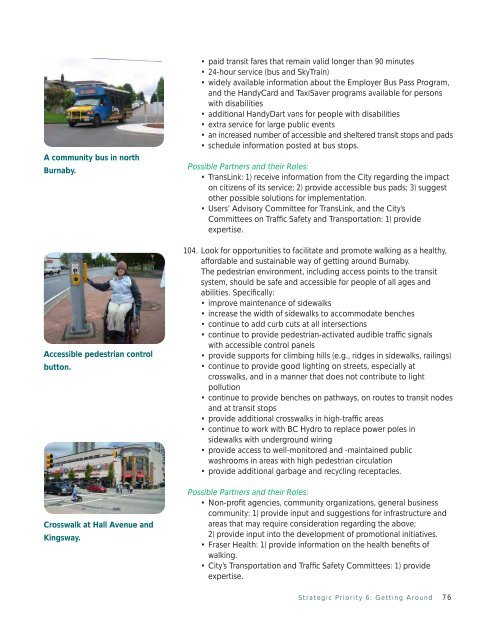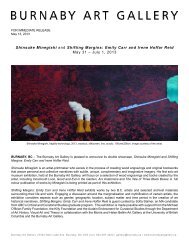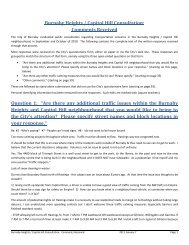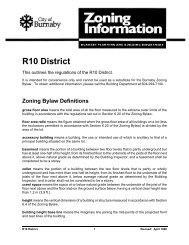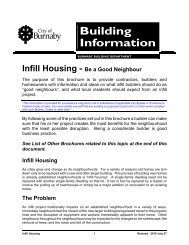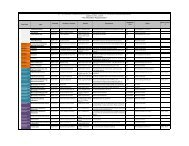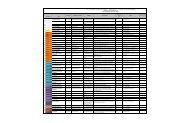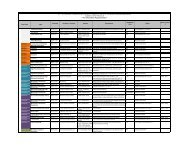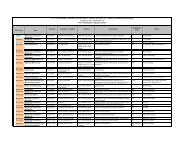Burnaby Social Sustainability Strategy - City of Burnaby
Burnaby Social Sustainability Strategy - City of Burnaby
Burnaby Social Sustainability Strategy - City of Burnaby
Create successful ePaper yourself
Turn your PDF publications into a flip-book with our unique Google optimized e-Paper software.
A community bus in north<br />
<strong>Burnaby</strong>.<br />
Accessible pedestrian control<br />
button.<br />
Crosswalk at Hall Avenue and<br />
Kingsway.<br />
• paid transit fares that remain valid longer than 90 minutes<br />
• 24-hour service (bus and SkyTrain)<br />
• widely available information about the Employer Bus Pass Program,<br />
and the HandyCard and TaxiSaver programs available for persons<br />
with disabilities<br />
• additional HandyDart vans for people with disabilities<br />
• extra service for large public events<br />
• an increased number <strong>of</strong> accessible and sheltered transit stops and pads<br />
• schedule information posted at bus stops.<br />
Possible Partners and their Roles:<br />
• TransLink: 1) receive information from the <strong>City</strong> regarding the impact<br />
on citizens <strong>of</strong> its service; 2) provide accessible bus pads; 3) suggest<br />
other possible solutions for implementation.<br />
• Users’ Advisory Committee for TransLink, and the <strong>City</strong>’s<br />
Committees on Traffic Safety and Transportation: 1) provide<br />
expertise.<br />
104. Look for opportunities to facilitate and promote walking as a healthy,<br />
affordable and sustainable way <strong>of</strong> getting around <strong>Burnaby</strong>.<br />
The pedestrian environment, including access points to the transit<br />
system, should be safe and accessible for people <strong>of</strong> all ages and<br />
abilities. Specifically:<br />
• improve maintenance <strong>of</strong> sidewalks<br />
• increase the width <strong>of</strong> sidewalks to accommodate benches<br />
• continue to add curb cuts at all intersections<br />
• continue to provide pedestrian-activated audible traffic signals<br />
with accessible control panels<br />
• provide supports for climbing hills (e.g., ridges in sidewalks, railings)<br />
• continue to provide good lighting on streets, especially at<br />
crosswalks, and in a manner that does not contribute to light<br />
pollution<br />
• continue to provide benches on pathways, on routes to transit nodes<br />
and at transit stops<br />
• provide additional crosswalks in high-traffic areas<br />
• continue to work with BC Hydro to replace power poles in<br />
sidewalks with underground wiring<br />
• provide access to well-monitored and -maintained public<br />
washrooms in areas with high pedestrian circulation<br />
• provide additional garbage and recycling receptacles.<br />
Possible Partners and their Roles:<br />
• Non-pr<strong>of</strong>it agencies, community organizations, general business<br />
community: 1) provide input and suggestions for infrastructure and<br />
areas that may require consideration regarding the above;<br />
2) provide input into the development <strong>of</strong> promotional initiatives.<br />
• Fraser Health: 1) provide information on the health benefits <strong>of</strong><br />
walking.<br />
• <strong>City</strong>’s Transportation and Traffic Safety Committees: 1) provide<br />
expertise.<br />
Strategic Priority 6: Getting Around 76


